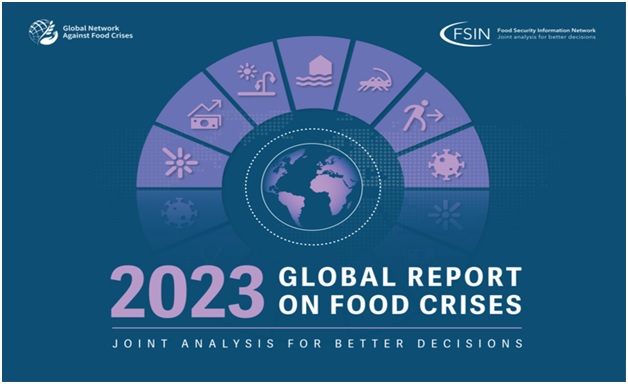Zero Hunger and the Global Report on the Food Crises 2023 (The Hindu)

- 24 Jul 2023
Why in the News?
The Global Report on Food Crises (GRFC) 2023, produced by GNAFC (Global Network Against Food Crisis), offers crucial insights into global food insecurity. It sheds light on the scale of hunger and the obstacles in achieving Sustainable Development Goal 2 - Zero Hunger.
By analyzing factors contributing to food insecurity and undernourishment, the report presents vital solutions to tackle this urgent challenge.
What is GNAFC?
GNAFC, founded in 2016 by the European Union, FAO, and WFP, is an alliance of humanitarian and development organizations collaborating to prevent, prepare for, and respond to food crises. Their collective efforts aim to support the achievement of Sustainable Development Goal 2, which is to End Hunger.
Key Findings:
- Food Insecurity and Undernourishment: According to the GRFC, hunger affected between 691 million and 783 million people in 2022, a significant increase from pre-pandemic levels in 2019. The number of individuals lacking adequate access to food rose to 2.4 billion in 2022, up by 391 million compared to 2019. Additionally, undernourishment prevalence reached 9.2% of the global population in 2022, compared to 7.9% in 2019.
- Positive Developments: Despite concerning figures, the report highlights some positive trends. Stunting among children under five decreased from 204.2 million in 2000 to 148.1 million in 2022, while child wasting declined from 54.1 million to 45 million during the same period. However, there was a slight, non-significant increase in child overweight or obesity, rising from 5.3% (33 million) in 2000 to 5.6% (37 million) in 2022.
- Cost of a Healthy Diet: The GRFC's revised analysis indicates that nearly 3.2 billion people worldwide couldn't afford a healthy diet in 2020, with a slight improvement in 2021. The global cost of a healthy diet rose by 6.7% from 2019 to 2021. The report projects that approximately 600 million people will face chronic undernourishment in 2030.
What is food security?
- Food security, as defined by the World Food Summit of 1996, refers to a state where all individuals have continuous physical and economic access to an adequate supply of safe, nutritious food that fulfills their dietary requirements and preferences, supporting an active and healthy lifestyle.
- The prevalence of moderate or severe food insecurity in the population is assessed using the Food Insecurity Experience Scale (FIES).
Drivers of Food Insecurity:
- Pandemic-related Disruptions: The COVID-19 pandemic, along with its associated lockdowns, economic downturns, and job losses in 2020, has significantly contributed to food insecurity, aggravating existing challenges.
- Russia-Ukraine War: Ongoing conflicts, such as the war in Ukraine, have further impacted global food insecurity, causing disruptions in food supply chains.
- Governmental Policies: Certain governmental policies may inadequately address food insecurity, posing obstacles to achieving Zero Hunger.
- Urbanization: The increasing trend of urbanization has led to changes in agrifood systems, resulting in varying food security levels among different population groups.
- Weather and Climate Extremes: Extreme weather events and climate variations have become the primary drivers of acute food insecurity in 12 countries. Droughts, floods, and storms severely disrupt agricultural production and food supply chains.
- Conflict: Ongoing conflicts and insecurity remain the most significant drivers of acute food insecurity in 19 countries/territories, affecting food access and availability in these regions.
Solutions for Achieving Zero Hunger:
- Promoting Healthier Food Outlets: The report highlights the need for policy incentives to encourage shops to sell fresh and minimally processed foods, improving access to nutritious diets and positively impacting food security.
- Enhancing Street Food Safety: Addressing street food safety, considering its widespread consumption by approximately 2.5 billion people daily, is crucial. Improving infrastructure and regulations surrounding street food can enhance nutritional safety and quality.
- Investing in Rural Infrastructure: Building rural infrastructure, including quality rural roads and linkages to main networks, can enhance connectivity for small farms and enterprises, boosting food production and distribution.
- Empowering Local Governments: Local governments play a significant role in implementing policies to ensure healthy diets are available and affordable for all. Their active involvement can lead to effective multilevel and multi-stakeholder mechanisms for achieving food security.
The Global Report on Food Crises 2023 highlights the ongoing issue of food insecurity worldwide. Implementing the recommended solutions and addressing the drivers of food insecurity will enable the international community to make significant progress toward achieving Zero Hunger and ensuring sufficient and nutritious food for all.
Recent Government Initiatives to Address Food Insecurity:
The Indian government has introduced various initiatives aimed at tackling food insecurity and alleviating poverty within the country. Some of these initiatives include:
- One Nation One Ration Card: Beneficiaries can access subsidized food grains from the Public Distribution System (PDS) across the country, regardless of their location.
- PM Garib Kalyan Ann Yojana (PMGKAY): This scheme ensures free food grains for vulnerable populations during crises like the COVID-19 pandemic.
- Atmanirbhar Bharat Rozgar Yojana: Focused on generating employment opportunities and promoting self-reliance, indirectly impacting food security.
- Pradhan Mantri Kisan Samman Nidhi: This program provides income support to small and marginal farmers, contributing to their economic well-being and food security.
- Intensified Mission Indradhanush 3.0 Scheme: Aims to boost vaccination rates among children and pregnant women, indirectly impacting child nutrition and health.
